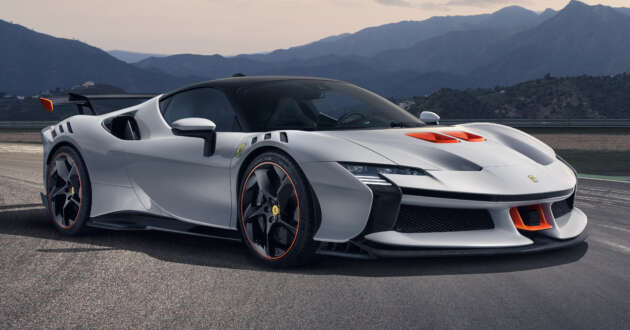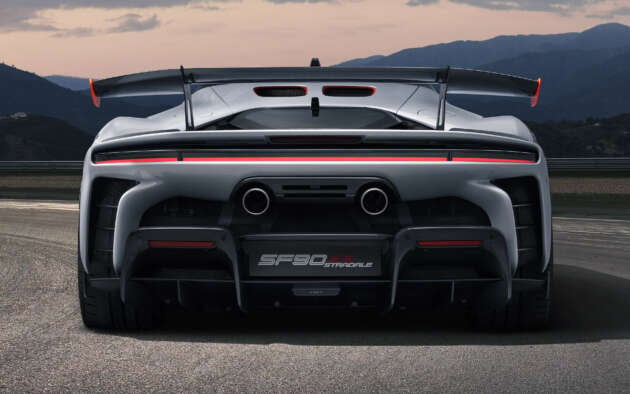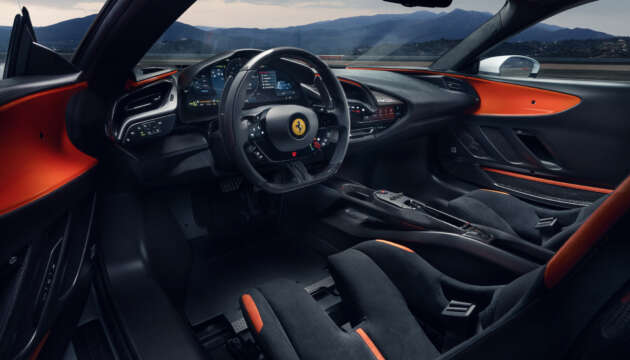The Ferrari XX Programme is where affluent clients turn to when they want to try out the Italian carmaker’s track-only specials like the FXX-K Evo, FXX Evo and 599XX. However, the cars used in the programme are not homologated for the road, which means their use is strictly limited to racetracks.
This all changes with the debut of the new SF90 XX Stradale and SF90 XX Spider, which are the brand’s first road-going cars in the XX Programme. Developed based on the existing SF90 Stradale and SF90 Spider, both models are more powerful, lighter and feature revised aerodynamics for improved performance.
Like other Ferrari specials, the SF90 XX will be limited in terms of production, with just 799 units of the Stradale and 599 units of the Spider planned. Unfortunately, all 1,398 examples have been accounted for, with deliveries set to begin in the second quarter of next year.
Those lucky customers will get a car that inherits the plug-in hybrid powertrain found in the SF90, so there’s a F154FB 4.0 litre twin-turbo V8 working together with three electric motors. For the SF90 XX, the V8 gets a power bump so it now develops 797 PS (786 hp or 586 kW) and 804 Nm of torque instead of the regular SF90’s 780 PS (769 hp or 574 kW) and 800 Nm.
According to Ferrari, this was possible by polishing the inlet and exhaust ducts, adopting new pistons, specific machining of the combustion chamber as well as increasing the compression ratio. Meanwhile, the electric motors – one between the engine and gearbox and two on the front axle – benefit from an extra boost vehicle dynamics logic so they now provide up to 233 PS (229 hp or 171 kW) – up from 220 PS (217 hp or 162 kW).
The extra boost from the electric motors is available when the car is in Qualifying mode and activated when the driver floors the throttle. This can be used up to 30 times before the 7.9-kWh battery is depleted – the all-electric range outside of Qualifying mode remains at 25 km.
Other notable powertrain revisions involve the eight-speed dual-clutch gearbox that now comes with a shift logic from the Daytona SP3, while a redesigned tube connecting the intake plenum to the cabin has been redesigned for more raucous harmonics.
With the mechanical changes, the SF90 XX’s total system output is 1,030 PS (1,016 hp or 747 kW), a 30 PS (30 hp or 22 kW) gain over the SF90. Ferrari quotes a 0-100 km/h time of 2.3 seconds for both body styles, which is 0.2 seconds faster than the SF90 range, although in the 0-200 km/h sprint, the Stradale is faster at 6.5 seconds compared to the Spider’s 6.7 seconds. The top speed is lower at 320 km/h instead of 340 km/h, largely because of the aerodynamic changes.
At 250 km/h, the SF90 XX delivers 530 kg of downforce, which is a significant jump from the regular SF90’s 390 kg. Key to this is the new fixed rear wing that works with the active spoiler carried over from the SF90 that switches between low-drag and high-downforce modes – the body is made slightly longer to accommodate this.
The front splitter is also specific to the SF90 XX and larger in size to send air to the redesigned underbody that incorporates a wider front diffuser and vortex generators. You’ll also find a pair of S-ducts on the bonnet that pull hot air from the front radiators and help increase downforce by 20%, joined by additional vents on the sides that send cool air to the engine intake in the rear buttress.
The layout of the medium temperature radiator that cools the electrical components is also reversed to increase efficiency and enclose a part of the car’s underbody – this idea was taken from the 296 GT3 racer. Air extractors for the wheel arches are also part of the aero package, along with a reworked rear diffuser that keeps the car’s aero wake compact.
Naturally, there are a lot of technologies to ensure maximum vehicle dynamics, including the debut of Ferrari Dynamic Enhancer 2.0 and the addition of the ABS Evo controller from the 296 GTB. The latter features the 6W-CDS suite of three yaw sensors that also helps more accurately read the car’s dynamic behaviour and optimising intervention (if needed) with much greater precision. Beefier and better-cooled brakes are also part of the SF90 XX’s arsenal track-focused tricks.
For even more of a race car feel, the cockpit gets parts with simpler shapes and plenty of carbon-fibre. Alcantara and technical fabric are also used for specific contact areas, while the carpeting has been removed entirely. The carbon seats are fixed, but they can be adjusted thanks to integrated elastic trim materials, while other changes include a pared-back centre console that sees the gear selector and power window switches being relocated.
All in, the SF90 XX Stradale has a dry weight of 1,560 kg, while the Spider is heavier at 1,660 kg due to its folding hardtop that can be operated in 14 seconds at speeds up to 45 km/h. Compared to the regular SF90, the weight savings are between 10 to 40 kg.
Are they expensive? Most definitely. According to Autocar, the SF90 XX starts from 770,000 euros (about RM3.9 million) for the Stradale coupe and increases to 850,000 euros (about RM4.3 million) for the Spider convertible.
Looking to sell your car? Sell it with Carro.





















